
Cloaks and Scarves – Gorgeous 3D Models in Fluid Motion
Sep 24, 2016 // Janet Hsu
Hello, and welcome to this week’s behind-the-scenes look at the creation and localization of Spirit of Justice! As a number of you finish the main game, I hope you’ll give the two Asinine Attorney parody shorts a play – they even come with these adorable pixel themes for your Nintendo 3DS!
This week, we’ll be looking at how the character models were created and animated with the two section leads, Mr. Ueda and Mr. Fujii! As I’m sure many of you have noticed, Spirit of Justice features even prettier models and even more fluid animation than its predecessor, and after you hear these two men’s tales, you’ll see why!
And with that, here’s Mr. Ueda!
——————————————————————
Soft Models, Strong Joints
Ugh. It’s still hot as anything, just like every summer in Japan. I’m Keiji Ueda, the model lead who’s bad at staying healthy in the summer and is always on the verge of a cold each and every year. As with Dual Destinies, I’m here to share a little about character modeling for Spirit of Justice. I hope you’ll join me on this little journey.
â—†From easy-peasy to despair
There were all sorts of challenges and struggles all throughout the development of Dual Destines as we transitioned from 2D sprites to 3D models, but I thought that since we’d more or less made all of the models already, and that since the art style wasn’t going to change, it would mean that Spirit of Justice was going to be a piece of cake. Little did I know that it would take more than twice the work of last time to create everything for this game… But just why did it have to be this way?! Well, here’s just a brief list of just some of the things we decided to do this time that we didn’t do in Dual Destinies .
 • Full-body character close-ups!
 • Moving cameras that would show the characters from a variety of angles at key points of the story!
 • Tons of soft, flowing materials such as cloth!
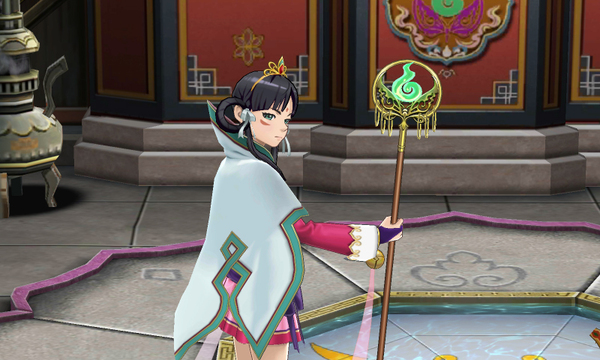 A cutscene where a character could be shown from any angle, including their back or full body
A cutscene where a character could be shown from any angle, including their back or full body
I know you may think this sort of camera work is pretty commonplace in games that use 3D models, but Ace Attorney hardly ever uses any fancy camerawork, which is meant to allow you, the player, to take your time and look at everything onscreen to your heart’s content. However, this makes any tiny thing that’s even slightly off really stand out. For example, if a character’s wrist or shoulder is positioned just a little strangely in one of their fixed poses, then it might lead you to think, “These models look a bit cheap” or “This model is bugging out.” And therein lies the rub: the instant that sort of thought crosses your mind, it will take you out of the story and make you think of the characters as simply a bunch of 3D polygon models.
Me and my section’s guiding principle for making Ace Attorney 3D character models came from when we were working on Dual Destinies. The producer, Mr. Eshiro, told us to basically do the impossible: create 3D models that were so good, you’d forget they were models to begin with. Add on top of that the additional caveats for this game, and we were faced with a truly desperate situation:
We had to create 3D models of characters whose designs feature a ton of flowing, moving parts like cloth, and will be shown from head to toe as they moved about – all without any noticeable oddities.
“Hold your horses, Mr. Fuse… Are you trying to kill me?” I thought.
â—†Making cutscenes really shine
Because the decision to include Rayfa’s performance of the Dance of Devotion was made early in the game’s development, we based the quality of all of Spirit of Justice’s cutscenes on this dance. How we achieved this higher quality was to first have the presentation and camera work done using the regular Rayfa model, and then to make detailed adjustments to her model.
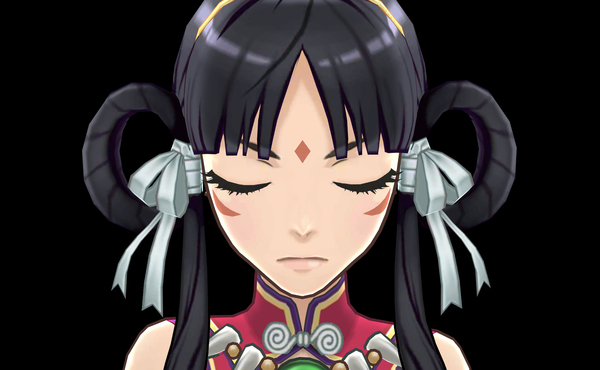
Rayfa gets even more detailed eyelashes than usual in these super close-up scenes
If there are any places where a model is sagging or sticking out, we’d go in and fix it by hand. In fact, the things that required the most attention from us were certain articles of clothing that characters like Rayfa or Andistan’dhin would wear. We made sure to pay even more attention to any model clipping this time than in Dual Destinies. Mr. Fujii will talk a little about this, too, but there were just a lot of cloth and other flowy bits that could cause clipping in this game!

Wow, that’s one saggy cloak…

Don’t raise your arms like that, Rayfa!
Because things like cloaks sit right on top of a character’s body, the character’s model tends to clip right through them when the character moves. And since Rayfa would be in constant movement during the entirety of the Dance of Devotion, we quickly requested that she always remove her cloak before she begins. That may or may not be the reason why there are a lot of characters that remove some piece of their clothing half-way through!!
And after we would make our adjustments, the animation section would work until their fingers bled to make sure there wasn’t any additional clipping in a single frame! Talk about handmade craftsmanship! We had to add a lot of wireframe joints, specifically to pieces of clothing and other moving parts, in order to achieve such perfection. And because there are also a lot of scenes featuring people’s hands in this game, we added a lot of joints to the characters’ fingers, too! And then, there are the joints we added to their faces in order to make them more expressive!! We modelers added so many joints this time around that we might’ve actually gone overboard because each model has, on average, a ton more joints than the models of Dual Destinies .
Anyway, we went through a lot and we might’ve put too much effort into all sorts of things, but if you think the characters look better for it, then that’s more than enough for me.
———————————————–
Thank you, Mr. Ueda for that look into character modeling! If there’s one thing I noticed, it’s definitely the number of joints in each lawyer’s finger! I don’t think those final dramatic finger points have ever looked or felt better!
You can tell, too, once you hear Mr. Fujii’s account of how the animation section put those joints to work when animating those glorious models Mr. Ueda’s section made.
———————————————–
The Devil’s in the Details
Hi everyone! I’m lead character animator Ryota Fujii. I’d like to share with you the little things we animators really paid attention to in the characters’ animations in Spirit of Justice .
â—†Obsessing Over Details in the Characters’ Presentation
We created the characters for Spirit of Justice as 3D polygon models, but in the end, they are displayed on a Nintendo 3DS screen. This means that even though we pose and create animations for the characters with a 3D rendering tool, sometimes, the characters wind up looking a little different once we see them on an actual Nintendo 3DS. For example, compare the two versions of Andistan’dhin below.

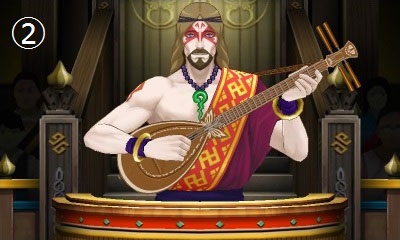
If you look real closely, especially at his face, I think you can quite easily tell that Andistan’dhin’s face in â‘¡ is a bit off.
Poor man! We couldn’t leave him in such a sorry state!!
Which is why, in cases like these, we make adjustments to a number of things, such as a character’s position in 3D space, until we get a much cleaner result as shown in â‘ , because no matter which character it is, we want to present them all at their very best.
â—†Obsessing Over Details in the Animation of Flowy Objects
The things we spent the most time on in this game were the animations for the many flowy objects in this game. What do I mean by “flowy objects”? I mean things like…
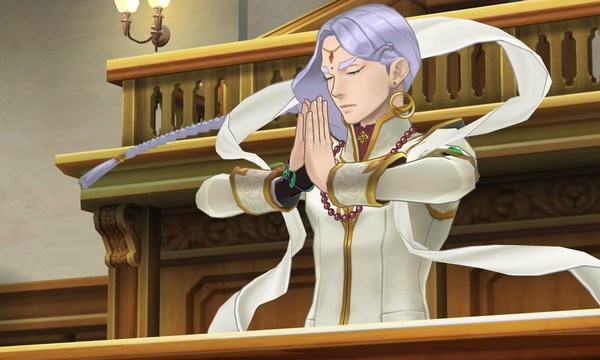
…Nahyuta’s floating scarf and his hair…
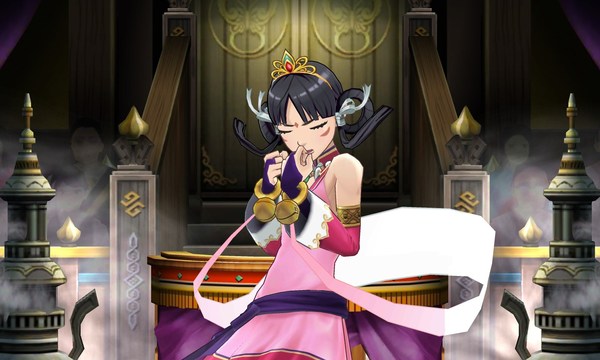
…and the cloth connected to Rayfa’s wrists, her hair and the ribbons in it… Oh, and her cloak, of course.
Now, you may be thinking, “But you can leave these kinds of things to a physics engine nowadays, can’t you?” but no, we can’t, because it wouldn’t look cool at all if we did.
Every aspect of a character is an important part of them, so the animations of even these flowy parts have to match the character themselves. We animators have our own ideas of what would look cooler or feel better in motion, and if we left it up to a physics engine, for better or worse, the animations would look too realistic, making it harder for us to give these flowing parts that nice anime touch they need to make them look like they belong on an Ace Attorney character.
That’s why the animations for the various flowy things on the many different characters were all painstakingly done by hand, but…! Mr. Fuse… Why are there so many characters with flowy bits on them this time around in the first place?!
*You’ll have to play for yourself to see just what kinds of characters appear in Spirit of Justice!
…So as you can see, Spirit of Justice’s character animations are also full of all sorts of detailed work. It would make me truly happy if you could spare even a second to take a look at the animations while you play!!
And with that, I’ll have to leave it here for today.
————————————
Thank you, Mr. Fujii! It sounds like you and Mr. Ueda both had quite the tough time with the many, many flowy things in Spirit of Justice. I hope you were able to get your revenge on the person who designed all of those characters and gave them their floating scarves and flowing hair! (I kid, I kid!)
Now, for those of you who have been playing through Spirit of Justice, I just wanted to share a few tales from the localization trenches. Admittedly, I didn’t do much outside of barking orders at Mr. Ueda and Mr. Fujii and giving feedback on their work. (Hey, I know I can’t draw, but I still had to do my job as localization director…!)
First up, I’m sure long-time fans noticed that Ema’s precious Snackoos bag got a redesign!

MUNCH MUNCH MUNCH MUNCH MUNCH
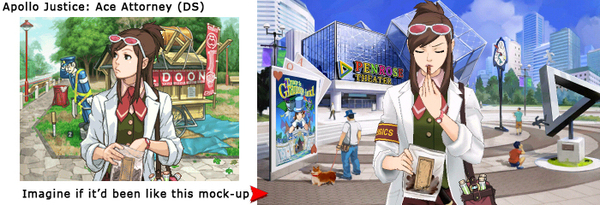
The Snackoos bag didn’t look so bad in the original DS version when we simply removed the Japanese lettering, but when Ema and her bag of snacks became all pretty in HD for the Nintendo 3DS, well, it looked a little sad and lonely with nothing written on the front label, so I asked Mr. Ueda to design and create the Snackoos bag you see in the game today. Taking inspiration from American packing design, he made it lively and colorful while keeping it simple by featuring the Snackoos front and center. He even designed it so that the word “Snackoos” is still visible when Ema is behind the witness’s stand! (How cool is that!)
Another reason I jumped at the chance to create a new Snackoos bag was because since we are now working with polygon models, all Mr. Ueda had to do was create one new texture and the rest of the animations would happen naturally. This modern method of animation is certainly a lot easier than re-drawing each frame of Ema’s sprite animation back in the day, which made this a much more feasible task for Spirit of Justice .
Without spoiling anything, next up is a character from Episode 4, “Turnabout Storyteller”: Bucky Whet.

Japanese version on the left, English version on the right
I think it’s pretty obvious why we had to change the back of his happi coat (it’s no fun if you can’t read what Bucky’s so proudly pointing at!), but there is sort of an Easter egg on the front that some of you sharp-eyed fans have already spotted.
Bucky’s name is spelled “Whet” in English, but if you look really carefully at the top two kanji characters on his right collar, you’ll see that they’re slightly different from the ones on his Japanese model. Just as how some foreign names have been anglicized throughout history, Bucky’s Japanese last name 上戸 (Ueto) turned into “Whet” at some point in their family’s history. Maybe when Whet Noodle No. 1 came to America, the immigration officer made a mistake? Or maybe the locals started using this spelling because it was easier? Who knows. But it’s certainly a great, big coincidence that his great-great-grandson is such a saké lover… or is it? (The same kanji 上戸 pronounced as “ jougo ” (ã˜ã‚‡ã†ã”) also means someone who loves alcohol.)
Actually, there’s another character in Episode 4 who has kanji characters for his localized name. It’s onscreen for less than a second, but I encourage you hardcore fans out there to find it and thank Mr. Eguchi of “ Mr. Famous ” fame for it. *grin*
Speaking of Mr. Eguchi, he will be here next week to talk about the full-length Special Episode that will be available starting next Thursday, “Turnabout Time Traveler,” and what you can expect from it. In addition, I’ll be holding him accountable for the insane premise of Episode 4, “Turnabout Storyteller.” If you haven’t finished Episode 4 yet by next week, consider this an incentive to do so. That way, you can read all of the supplementary info I’ve wrung out of him in a special one-on-one exclusive interview! We’ll also have a closing from Mr. Yamazaki about the secret “secondary theme” of Spirit of Justice. So be sure to stop by one last time next week!
Until then!

PS: I reeeeeally wanted to talk about this guy here, but since he’s in episode 5, I didn’t want to spoil anything. But I will say that Mr. Ueda and Mr. Fujii had their hands full re-doing some parts of his models and animations, especially those related to his now-horizontal-and-triangular nameplate… (I’m so sorry for being such a nitpicky pain in the behind, Mr. Ueda and Mr. Fujii!!! Please forgive meeeeee!!!)
PPS: That texture was Mr. Ueda’s idea of a placeholder – just a little something to remind himself to come back and redo the model and textures for this particular, um, vehicle. Some people on the dev team actually thought this was the real, finalized localized version for a while… Oh, Mr. Ueda. Your idea of a joke… hit a little too close to home for this American…
Catch up on previous blog entries here!
-
Brands:Tags:
-

Loading...
Platforms:
 A cutscene where a character could be shown from any angle, including their back or full body
A cutscene where a character could be shown from any angle, including their back or full body






